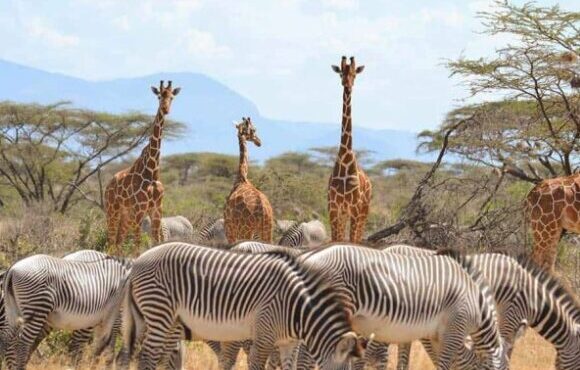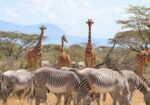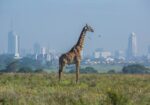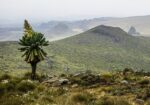Overview
Samburu National Reserve is the most popular safari destination in northern Kenya, set in the hot, semi-arid lowlands characteristic of this region. Measuring just 165 square kilometers, the reserve boasts unrivaled natural beauty, with its striking semi-arid terrain, rugged kopjes, dramatic hills, and the winding Ewaso Ng’iro River that brings life to the landscape. This unique ecosystem supports a diverse array of wildlife and bird species specially adapted to the dry, rocky conditions.
Although widely recognized, Samburu remains one of the less visited parks, offering a tranquil and exclusive safari experience for those seeking to escape the crowds. Its relatively small size further enhances its appeal, making it easier for visitors to explore thoroughly and immerse themselves in the stunning landscapes and abundant wildlife it has to offer.
Attractions and Unique Features of Samburu National Reserve
Wildlife
Samburu is renowned for its incredible wildlife, particularly the “Samburu Special Five”—a group of unique animals found predominantly in northern Kenya. These include: Grevy’s zebra, Reticulated giraffe, Beisa oryx, Gerenuk, and Somali ostrich.
In addition to the Special Five, Samburu is one of the best places to view large herds of elephants. Other herbivores include warthogs, Grant’s gazelles, Kirk’s dik-diks, impalas, and waterbucks, particularly around the marshes. Primates like olive baboons can be spotted swinging through the trees, while the Ewaso Ng’iro River is home to pods of hippos and massive Nile crocodiles.
Samburu is also a sanctuary for rare species, such as the critically endangered pancake tortoise (Malacochersus tornieri), a fascinating reptile found in the reserve.
Predators are another highlight, with lions, leopards, and cheetahs frequently seen. The reserve is also home to African wild dogs, which are a thrilling sight for safari-goers. One famous predator, Kamunyak, a lioness known for adopting an oryx calf, lived in Samburu but was last seen in 2004.
Birdlife
Samburu is a birdwatcher’s paradise, boasting over 450 recorded bird species, including those adapted to the arid northern bush and riverine forests. The park is home to vibrant species such as sunbirds, bee-eaters, kingfishers, woodpeckers, and hornbills, adding a splash of color to the rugged landscape. Birds of prey, including the palm-nut vulture, Verreaux’s eagle-owl, Egyptian vulture, and lappet-faced vulture, are also frequently spotted, showcasing the park’s rich avian diversity.
Samburu is of global conservation significance, as it hosts species like the lesser kestrel and Taita falcon, both considered conservation priorities. Additionally, vulnerable species such as the African darter, great egret, white-headed vulture, martial eagle, and yellow-billed oxpecker further highlight the reserve’s importance as a sanctuary for avian biodiversity.
Scenic Landscape
Samburu National Reserve stands out for its semi-arid environment, shaped by a desert-like climate that sets it apart from Kenya’s other wildlife sanctuaries, which are often lush and green. Despite the dry conditions, Samburu possesses remarkable scenic beauty, with the Ewaso Ng’iro River as its defining feature. This life-giving river winds through the rugged, semi-arid terrain, supporting a diverse ecosystem and adding vibrancy to the landscape.
The reserve’s serene environment is characterized by open savannah plains, scrubby bushlands, and riverine forests lined with acacia and doum palms along the riverbanks. The terrain is further adorned with towering termite mounds that resemble natural mud skyscrapers, adding a unique touch to the scenery.
Cultural Experiences
Samburu County is home to the Samburu people, a semi-nomadic community celebrated for their deep connection to the land and wildlife. The Samburu National Reserve is named in their honor, reflecting their status as the ancestral inhabitants of this region. For millennia, the Samburu have lived in harmony with the wildlife, playing a crucial role in preserving this sanctuary.
Despite the challenges of modernization, the Samburu have steadfastly maintained their traditional way of life, including their distinctive customs, vibrant attire, and nomadic practices. Visitors to the reserve have the unique opportunity to interact with the Samburu people, gaining a deeper understanding of their rich cultural heritage, unique lifestyle, and sustainable practices that foster coexistence with nature. This cultural immersion adds a meaningful dimension to the Samburu safari experience.
Activities and Experiences in Samburu National Reserve
Game Drives
Guided game drives in Samburu National Reserve allow visitors to explore its breathtaking landscapes and diverse wildlife from the comfort of 4×4 vehicles equipped with pop-top roofs for optimal viewing. These drives are typically scheduled during the early morning and late afternoon when animals are most active in the cooler hours. During the heat of the day, many animals retreat to rest, making them harder to spot. For a deeper, more immersive experience, full-day game drives can also be arranged.
Bird Watching
Samburu is a haven for bird enthusiasts, boasting over 450 recorded bird species across its varied habitats. The extraordinary diversity of avian life makes the reserve a prime destination for birdwatching, offering countless opportunities to observe and photograph unique species.
Guided Nature Walks
Walking safaris provide an intimate and unique way to experience the African wilderness. In Samburu, these guided nature walks allow visitors to explore the area on foot, offering a closer connection to the environment without the use of vehicles. There are two types of nature walks available: short walks organized by camps and lodges within the reserve, and more extensive walking safaris in adjacent community wildlife conservancies, offering well-planned, immersive experiences.
Cultural Tours
Visitors can immerse themselves in the rich cultural heritage of the Samburu people by touring their villages. These cultural tours provide a firsthand experience of their unique customs, practices, and nomadic way of life. Guests gain a deeper appreciation of how the Samburu people have contributed to the conservation and ongoing success of the reserve through their harmonious coexistence with nature.
Photography
Samburu’s stunning scenery and vibrant wildlife make it a dream destination for photographers. The reserve’s semi-arid landscape provides a dramatic backdrop for capturing incredible wildlife moments, while its diverse features—including the Ewaso Ng’iro River, rolling hills, savannah plains, bushlands, acacia woodlands, and iconic doum palms—offer endless opportunities for breathtaking and varied photography.
Best Time to Visit Samburu National Reserve
Samburu National Reserve, located in a semi-arid region, is a year-round safari destination offering excellent wildlife viewing opportunities regardless of the season.
Dry Season
The dry months, typically from June to October and January to February, are considered the best time for wildlife viewing. With minimal rainfall, vegetation becomes sparse, and animals congregate around water sources, especially along the Ewaso Ng’iro River, making them easier to spot.
Rainy Season
The rainy months, from March to May and November to December, transform the reserve into a lush, green haven. While wildlife remains abundant during this period, the taller grass and dense vegetation can make animal spotting more challenging. However, the wet season is ideal for birdwatching, as many migratory birds flock to the area, enhancing the diversity of avian species.
Where to Stay at Samburu National Reserve
Samburu National Reserve offers a variety of accommodation options, both within the reserve and in the surrounding community wildlife conservancies, to cater to various preferences and budgets. Visitors can opt for budget-friendly campsites with basic facilities, ideal for those seeking an affordable and adventurous stay. For travelers looking for more comfort and luxury, the reserve boasts upscale lodges and tented camps that provide premium amenities and an elevated safari experience.
How to Get to Samburu National Reserve
Samburu National Reserve is located in northern Kenya, within Samburu County, approximately 43 km from Isiolo Town, which serves as the main gateway to the reserve. It lies about 350 km northeast of Nairobi, Kenya’s capital city. The park is easily accessible by both road and air, making it a convenient destination for travelers seeking an unforgettable safari experience.
By Road: Traveling by road is an enjoyable and cost-effective option, especially in 4×4 safari vehicles equipped for comfort. The 350 km journey from Nairobi to Isiolo takes approximately 5 hours via the Nyeri-Nanyuki-Isiolo route. Along the way, travelers can marvel at Kenya’s diverse and scenic countryside. Once in Isiolo, visitors continue to Archer’s Gate, the main entry point to the reserve.
By Air: Several airlines, including Air Kenya and Safarilink, offer daily return flights from Wilson Airport in Nairobi to airstrips within Samburu National Reserve. The flight takes approximately 1.5 hours, providing a quick and efficient way to reach the park. Upon arrival, prearranged safari transportation ensures seamless transfers to accommodations or directly into the park.
Samburu National Reserve Safari Packages
Samburu National Reserve caters to a variety of travelers with safari packages ranging from budget-friendly options to midrange and luxury experiences. At Giorgi Safaris, we specialize in organizing tailor-made Kenya safari holidays, ensuring every traveler’s preferences and needs are met.
Our services include experienced professional guides, transport in comfortable 4×4 safari vehicles, and thoughtfully designed itineraries that highlight the best of Samburu. We have partnered with top accommodation providers across the destinations featured in our itineraries, guaranteeing a seamless and memorable safari experience.
If you have any questions, need recommendations for your visit to Samburu National Reserve, or wish to book a safari, feel free to contact us via email. Our team is committed to responding promptly and assisting you in planning an unforgettable adventure.
Conclusion: Why Visit Samburu National Reserve
Samburu National Reserve is renowned for its unmatched natural beauty, breathtaking landscapes, and diverse wildlife, including the iconic Samburu Special Five—species found nowhere else in Kenya outside this region. The reserve also offers visitors the unique opportunity to experience the vibrant culture of the Samburu people, making it a truly special destination in Kenya’s safari circuit.
With a variety of activities to enjoy, such as game drives, birdwatching, guided nature walks, cultural tours, and photography, Samburu National Reserve guarantees an unforgettable African safari experience. Whether you’re seeking adventure, tranquility, or cultural enrichment, this remarkable destination has something for everyone.
Contact us today to begin planning your journey to Samburu National Reserve and embark on an adventure that promises memories to last a lifetime.
Planning Your Samburu National Reserve Safari in Kenya? Start Here!
At Giorgi Safaris, we specialize in tailor-made Kenya safari holidays crafted to match your interests, schedule, and travel style. Our packages include expert safari guides, reliable 4×4 vehicles with pop-up roofs for optimal game viewing, and thoughtfully designed itineraries that showcase the very best of each destination.
We partner with trusted lodges and camps to ensure your experience is smooth, enjoyable, and truly unforgettable from the moment you arrive to the moment you leave.
Contact Giorgi Safaris today to book your safari or request a custom itinerary tailored to your travel goals. We’re here to help you make the most of your time in one of Kenya’s most iconic and accessible wildlife destinations.









